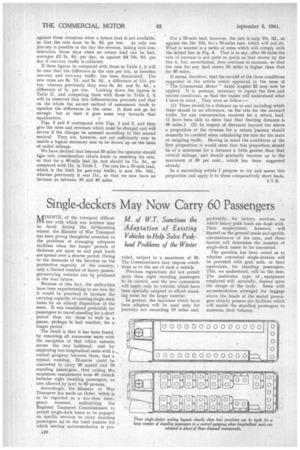Single-deckers May Now Carry 60 Passengers
Page 22

If you've noticed an error in this article please click here to report it so we can fix it.
M. of KT. Sanctions the Adaptation of Existing Vehicles to Help Solve Peakload Problems of the Winter
1ILIILNDFUL of the transport difficulal ties with which war workers may be faced during the forthcoming winter, the Minister of War Transport has been giving thoughtful attention to the problems of arranging adequate facilities when the longer periods of darkness are upon as and peak loads are spread over a shorter period. Owing to the demands of the Services on the productive capacity of the country, only a limited number of heavy passenger-carrying vehicles can be produced in the near future.
Because of this fact, the authorities have been experimenting to see how far it would be practical to increase the carrying capacity of . existing single-deck buses by an altered disposition of the seats. It was considered preferable for passengers to travel standing for a short period than for them to wait in a queue, perhaps in bad weather, for a longer period.
The result is that it has been found, by removingall transverse seats with the exception of that which extends across the rear bulkhead, and by employing two longitudinal seats with a , central gangway between them, that a typical, existing, 32-seater could be converted to carry 30 seated and 30 standing passengers, thus raising 1.4.e maximum cemplement from 40 (which includes eight standing passengers, as now allowed by law) to 60 persons.
Accordingly, the Minister of War Transport has made an Order, which is to be regarded as a war-time emergency measure, authorizing the Regional Transport Commissioners to permit single-deck buses to be engaged on specific services to carry standing passengers up to the total number for which seating accommodation is pro vided, subject to a maximum of 30. The Commissioners may impose conditions as to the use of such a vehicle.
Previous regulations did not permit more than eight standing passengers to be carried, and the new concession will apply only to vehicles which have been specially adapted to afford standing room for the larger number.
In general, the machines which have been ,adapted will be used only for journeys not exceeding 10 miles and, preferably, for factory services, on which heavy peak loads are dealt with. Their employment, however, will depend on the general needs and specific circumstances of the area, and these factors will determine the number of single-deck buses to be converted.
The question has been raised as to whether converted single-deckers will be provided with grab rails, or their equivalent, for standing passengers. This, we understand, will be the case. The particular type of equipment employed will, naturally, depend upon ' the design of the body. Some with accommodation arranged for luggage above the heads of the seated passengers already possess the facilities which will enable the standing passengers to maintain their balance.




















































